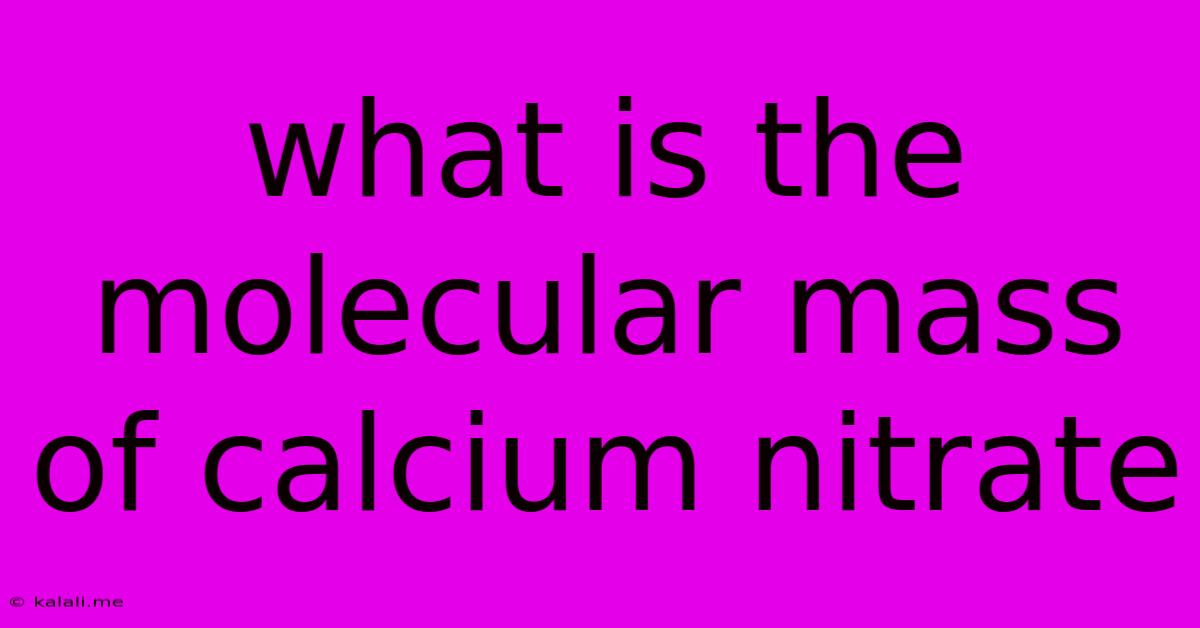What Is The Molecular Mass Of Calcium Nitrate
Kalali
Jun 13, 2025 · 3 min read

Table of Contents
What is the Molecular Mass of Calcium Nitrate? A Comprehensive Guide
Meta Description: Learn how to calculate the molecular mass of calcium nitrate (Ca(NO₃)₂) and understand the importance of molar mass in chemistry. This guide provides a step-by-step calculation and explains the concept clearly.
Calcium nitrate, a common chemical compound with the formula Ca(NO₃)₂, finds applications in various fields, from fertilizers to explosives. Understanding its molecular mass is crucial for numerous chemical calculations and applications. This article will guide you through calculating the molecular mass of calcium nitrate and explain the significance of this value.
Understanding Molecular Mass
Before we dive into the calculation, let's clarify what molecular mass represents. Molecular mass, also known as molecular weight, is the sum of the atomic masses of all the atoms present in a molecule. It's expressed in atomic mass units (amu) or Daltons (Da). This value is essential for determining the amount of substance in moles (using Avogadro's number), which is fundamental in stoichiometry and other chemical calculations.
Calculating the Molecular Mass of Calcium Nitrate (Ca(NO₃)₂)
To calculate the molecular mass of calcium nitrate, we need the atomic masses of its constituent elements: calcium (Ca), nitrogen (N), and oxygen (O). These values can be found on a periodic table. Generally accepted values are:
- Calcium (Ca): 40.08 amu
- Nitrogen (N): 14.01 amu
- Oxygen (O): 16.00 amu
Now, let's break down the calculation:
-
Calcium (Ca): There's one calcium atom per molecule of calcium nitrate, so its contribution is 40.08 amu.
-
Nitrogen (N): There are two nitrogen atoms per molecule (from the NO₃ group multiplied by the subscript 2), contributing 2 * 14.01 amu = 28.02 amu.
-
Oxygen (O): There are six oxygen atoms per molecule (3 oxygen atoms per nitrate group, multiplied by 2 nitrate groups), contributing 6 * 16.00 amu = 96.00 amu.
-
Total Molecular Mass: Adding the contributions from each element: 40.08 amu + 28.02 amu + 96.00 amu = 164.10 amu
Therefore, the molecular mass of calcium nitrate, Ca(NO₃)₂, is approximately 164.10 amu.
Importance of Molar Mass
The molecular mass is directly related to the molar mass. The molar mass is the mass of one mole of a substance, expressed in grams per mole (g/mol). Since one mole contains Avogadro's number (6.022 x 10²³ particles), the molar mass is numerically equal to the molecular mass but with units of g/mol. Therefore, the molar mass of calcium nitrate is approximately 164.10 g/mol.
This value is essential for various chemical calculations, including:
- Stoichiometry: Determining the amounts of reactants and products in chemical reactions.
- Solution preparation: Calculating the mass needed to prepare a solution of a specific concentration.
- Titrations: Determining the concentration of an unknown solution.
Understanding the molecular mass of calcium nitrate is fundamental for anyone working with this compound in a chemical context. This calculation demonstrates a fundamental principle of chemistry and highlights the importance of atomic masses in determining macroscopic properties.
Latest Posts
Latest Posts
-
Milk Of Magnesia Acid Or Base
Jun 14, 2025
-
Application Of Matrix And Determinants In Real Life
Jun 14, 2025
-
Which Is The Largest Fraction 3 4 7 8
Jun 14, 2025
-
The Three Regions On A Pressure Enthalpy Chart Are
Jun 14, 2025
-
Reaction Of Iron With Hydrochloric Acid
Jun 14, 2025
Related Post
Thank you for visiting our website which covers about What Is The Molecular Mass Of Calcium Nitrate . We hope the information provided has been useful to you. Feel free to contact us if you have any questions or need further assistance. See you next time and don't miss to bookmark.